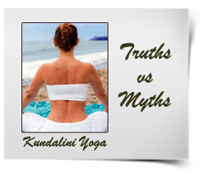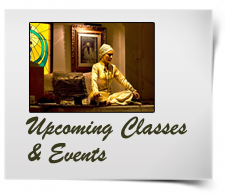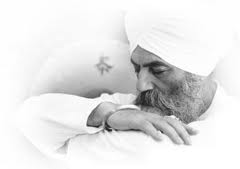| |
|
|
|
Member of IKYTA
|
|
Registered Yoga Teacher
|
|
|
Certified Practitioner II
|
|
|
Member of SNR Spain
|
|
|

|
|
|
|


KUNDALINI YOGA: TRUTH vs. FICTION & Preconceived Ideas
|
| |
|
 “In Kundalini Yoga they make you twist
“In Kundalini Yoga they make you twist
in weird impossible positions”
|
In this particular form of yoga, it is seldom the case; you do not have to bend like a pretzel to practice Kundalini Yoga. While it is true that some of the most advanced postures can look daunting, they are seldom, if ever, used in regular Kundalini Yoga classes. Most importantly: postures are adaptable. Unlike in other forms of yoga, it is not a question of achieving the perfect posture but rather reaching for the correct angle on your way there, and observing your habitual ways of avoiding being present under pressure & constraints, so you can bring yourself back to neutral. So, for example, if you cannot reach your toes then reach for your ankles or your knees, but try to keep a straight back and bend from the waist, keep focusing on coordinating your breathing with your movement. Not only will your flexibility greatly improve that way, but the unconscious mental pattern that keeps you less flexible in the corresponding area will also shift gradually: a double-win. Of course there are added benefits to mastering a posture in its optimum form, but by no means is it a pre-requisite to this yoga bringing positive changes to your life.  |
| |
|
|

“I am too stiff to do Kundalini yoga”
|
That’s impossible: Because the postures work through “angles”, even very small movements will have great effects, so it doesn’t matter how rigid your body has become, the exercises and postures will have a positive effect, stimulating the glandular (endocrine) system into action, quick-starting the lymphatic system into detoxification and challenging the nervous system into greater tolerance. The controlled breathing alone will help bring relaxation to areas of constriction.
Each individual is in process, so don’t worry about how you will “look” while working on yourself. The teacher is not there to gauge and correct you, but to support you in your process. If you are unsure, check with your doctor whether you have a special condition that would prevent you from doing certain movements. When I started yoga I had become not only uncoordinated but also stiff as a wooden stick. Now I sometimes can’t believe some of the postures I am able to hold. This yoga should be suitable for everyone, even the elderly who have to sit on a chair, as all postures are adaptable.  |
| |
|
|
 “Yoga is slow and boring”
“Yoga is slow and boring”
|
Hardly: Yoga is now used as a general term that covers many different styles and practices, from the most spiritual to the simply body-image conscious. In this Kundalini Yoga, one of the first steps is to warm up the body, then to stimulate the endocrine (glandular) and lymphatic systems, so the physical exercise portion of the class can be quite lively and vigorous, depending on the program of the class that day and the personality of the teacher.
Other steps of the class will be spent in postures that will test your mettle, your grit and your resistance. The mind, which likes what it can control, doesn’t want to be challenged and it defends itself trying to convince you that you are in pain or tired or bored. Believe it or not, falling asleep while being challenged is a form of resistance, I have witnessed it in acting classes too. So experience whether the “boring” and “slow” opinion you may have is due to your not being used to “going inward” and confront certain aspects of yourself, or whether you just prefer a yoga class that is more vigorous in its physical segment, which is just a matter of choosing a different Kundalini Yoga class or teacher.  |
| |
|
|
 “They use weird words, why not
“They use weird words, why not
use “regular” words and chants?”
|
The language used in this form of yoga is unusual. It is called Gurmukhi (1), and is an adaptation of the old liturgical (ceremonial) Eastern language Sanskrit. The purpose of using this language is that it is not based on the meaning of its words, but on its highly sophisticated sound current and its effects on the brain frequencies. The hard palate has many meridian points that are triggered in very specific patterns by the tip of the tongue stroking it rhythmically when using this language in its proper “raag” (a combination of “mood” and rhythm). If you watched the series “Fringe” you may remember that some of the characters would type on an old typewriter that would send messages to “the other side”. Well, it’s a bit like that except, in this case, the “other side” is your own subconscious.
(1) Gurmukhi means “from the mouth of the Gurus(2)”, which by extension means the language of the saints.
(2) Guru is a word that has been distorted out of his beautiful initial meaning: “Gu” is “darkness” and “Ru” is “light”. A “guru” is what or who enables you to cross over from darkness into light, from ignorance to enlightenment. By extension the term refers to a teacher or a guide, but it is by no means restricted to referring to a person.  |
| |
|
|
 “It’s a religion”
“It’s a religion”
|
I will let teacher Shakti Parwha Kaur (1), who is a devoted Sikh, talk about the difference: “Kundalini Yoga is not a religion, it is a Sacred Science. It is sacred because it deals with the G.O.D. in you, that which Generates, Organizes & Delivers/Destroys. It is scientific because it provides a technology, a method by which anyone who practices it can experience that Divine Identity within. The way you choose to worship that GOD is your religion (2).”
Yogi Bhajan himself coined the best definition of Kundalini Yoga for me: “Humanology”, the study & science of what it is to be human.
The confusion arises from the fact that Kundalini Yoga uses the same sound current technology as the Sikh religion. This “Naad” (sound current) is a sacred language compiled by Saints who lived their lives in a way that left a legacy of example and uplift for the human race, saints like you find in any religion. This language has stayed pure to its initial form as a “technological tool” and is effective regardless of the meaning of its words. Yogis can be of diverse religions. Many Sikhs never practice yoga and in India some even reject it.
Yogi Bhajan was a yoga Master and a Sikh. These days, the House of the Sikhs is the custodian of these teachings. But if there are “intersections” of technology between the two, Kundalini Yoga is not Sikhism, and vice versa. Most of the newest waves of certified Kundalini Yoga teachers have little to do with Sikhism as a religion and come from very varied religious backgrounds, or even none at all. What is important is to respect and understand the “sacred” aspect of this yoga, which goes way beyond a physical practice.
In my 14 years - & counting - of study and practice of Kundalini Yoga and its healing branch, I have never been coerced or manipulated into adopting Sikhism as a religion, which has given me the freedom to explore the technology of the sound current inherent in both, without fear of being proselytized. My studies of the yogic system, as taught by Yogi Bhajan, have helped me not only to heal but also to deepen my understanding of the religion I was born into, which I have never had to deny. It has also broadened my horizons and stretched my tolerance of other practices and religious views, and of humanity in general.
(1) Shakti Parwha Kaur was Yogi Bhajan’s first student in the US and remained very close to him throughout his entire life. A lot of the teachings he imparted to her first, so the information she shares is always completely accurate. She is deemed “the mother of 3HO”, the organization founded by Yogi Bhajan.
(2) Quote from “The Flow of Eternal Power” (see Resources page for more details)  |
| |
|
|
 “Yoga is for hippies and weirdoes”
“Yoga is for hippies and weirdoes”
|
Kundalini Yoga is for householders, for people who live “in the world” and just want their life to work better, to function better as human beings. The usual clichés of yoga adepts as body image obsessed, or odd-looking individuals with odd eating habits or airy-fairy ungrounded people is a very narrow view. Some students & teachers do adopt extreme alternative lifestyles. But these clichés are more the product of marketing impact or individual choice than the reflection of the full scope of the actual reality of students and teachers. The truth is, as you progress on your way to well being, you are less and less attracted to foods and habits that are detrimental to the human body. You may become naturally inclined to stop smoking, drinking, eat more vegetables, smile more often and invite less chemicals into your life.
It is true that when Yogi Bhajan arrived in the West in 1968/69 with Kundalini Yoga, most of the people who were open enough to try something this new were rebels of one sort or another, “hippies” who had a sense of “something greater” but did not know how to access it. They searched outside of the establishment in all possible forms of excesses for that feeling of expansion. Yogi Bhajan honored their pioneering spirit, courage to explore new boundaries and sacrifice (many of them died during their experiences of “exploration”): he instituted that every single Kundalini Yoga class ends with a heart-centered folklore song that his early students had sung to him as a gift, “May the longtime sun shine upon you”.  |
| |
|
|
 “I am too old to start yoga”
“I am too old to start yoga”
|
One of my esteemed colleagues specializes in Kundalini Yoga for the elderly. I observed a class that she taught to 12 of her regular students from age 80 to 90-and-counting, some with Alzheimer and some with Parkinson’s disease. All postures, movements, meditations are adaptable. They follow the principle of “angles of triangles” to cut through our habitual physical and mental patterns. If you aim for the right angle, forget the destination posture, it will have a positive effect on your nervous, glandular and mental systems. And the sound current and breathing patterns are extremely potent by themselves. These elderly students would not miss their class for the world.
*Mary aka Fatehbir Kaur (see Resources page for more details)  |
| |
|
|
 “Kundalini Yoga is not for tough guys”
“Kundalini Yoga is not for tough guys”
|
It is frequently assumed that if you are athletic Kundalini Yoga will be “too easy” for you. It is also frequently assumed that if you are already flexible, for example because you have previously practiced another form of yoga, Kundalini Yoga will not be challenging enough for you. I see evidence to the contrary every day in class. “Tough guys” can have as hard a time with “stretch pose” as anyone. That’s because this yoga does more than work on the physical level: it works with the energetic dynamics of your entire system and their corresponding mental and emotional patterns. A variation of postures and meditations will be easy for some and present a challenge for others. It has ultimately not much to do with muscle strength.  |
| |
|
|
| |
|
|
|
|
 |
|
 |
| |
|
Teacher Los Angeles
|
|
|
Available for
Special Events
|
| |
|
| |
|
| |
|
